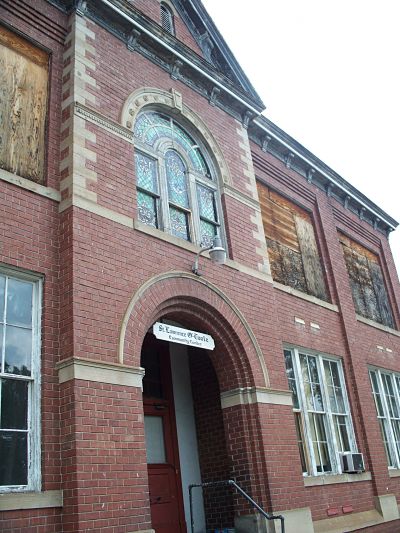 On Wednesday, November 28, 1917, St. Lawrence was hosting the annual Thanksgiving program. Students, mothers, and friends were gathered to celebrate the upcoming holiday. Unfortunately, the joyful event took a tragic turn around 3:00 p.m. when a gas leak in the fuel room caused an explosion.
On Wednesday, November 28, 1917, St. Lawrence was hosting the annual Thanksgiving program. Students, mothers, and friends were gathered to celebrate the upcoming holiday. Unfortunately, the joyful event took a tragic turn around 3:00 p.m. when a gas leak in the fuel room caused an explosion.
According to the Morning Irontonian, Walter Grant, a local plumber, and Frank Cannon, the St. Lawrence sexton, went to the basement to repair leaky pipes that had been causing problems for a long time. At the same time, Dr. Cotter was testing the gas jets after being told two people at the program smelled gas. Mr. Cannon gave Grant a lamp (probably an oil lamp) before entering the small space located under the stage. That lamp ignited the gas causing the explosion. Grant ran from the school to the brewery across the street and was later transported to the Roosevelt Hospital. Mr. Cannon ran back to the auditorium to help the women and children present.
Inside the auditorium, chaos reigned. During the explosion, the floor lifted up and a large hole formed filled with flames. The entire front of the room was engulfed with flames. Adults rushed to help the injured children. Some children used their own hands to put out flames on their classmates. Sheila King, a ten year old student, pulled a classmate through a window to safety by her hair. Other noted heroes of the day include Delbert Corn, Frank Cannon, and Mrs. William King. Because part of the floor was concrete, fewer people suffered severe injury. Twenty-five to thirty people were burned.
After the explosion, many of the children were moved to the homes of the St. Lawrence Sisters and to other homes nearby. Some of the burned children ran to their homes “some distance away.” (quote from Morning Irontonian) Dr. Homer Snyder was the first physician to arrive on scene, but some students had already been transported to the offices of Dr. E. E. Wells, and Drs. Lynd.
By evening, the explosion claimed its first life. Elizabeth Haas, ten years old, died from her burns at the Roosevelt Hospital at 8:30 p.m. She was near the flame engulfed hole that appeared the floor after the explosion. Her clothing caught fire. Mrs. William King caught the distraught girl and tore her flaming clothes from her. This act kept Elizabeth from burning to death in the school. Although she suffered burns to her hands and arms, she did apply olive oil to Elizabeth’s burns to relieve some of the pain. Elizabeth was the daughter of Mr. and Mrs. John Haas and resided at 713 Mill Street. She had two brothers, Clifford and Harold, who also received burns. Her brothers’ injuries were minor and they were sent home to recover.
Other victims sent to Roosevelt Hospital includes: John Somers (age 15), Francis Haley (age 13), Alice O’Leary (age 9), Helen McMahon (age 11), Walter Grant (age 23 and the plumber), and Anna Haley (age 14).
Some of the injured were sent to the Keller Hospital. Among those patients was Mrs. Frank Eisle, Ella Ward (age 15), Elizabeth Cloran (age17), Meredith McGinley (age 17) and Mrs. Kate Doran. Mrs. Doran was discharged from the hospital by the following day.
Some students were injured, but were sent home to recover. Among those injured was Lawrence Gossett (age 14)*, Clifford Haas (age 14), Harold Haas (age 12), Charles Haley (age 15), Sheila King (age 10), Mrs. W. A. King, Dr. J. H. Cotter, Mrs. Bowers, Helena O’Leary (age 14), Louisa Barron (age 14), Margaret Culligan (age 10), Ineas Lawless (age 9), Helen Mahl (age 16), Carinus York (age 17), Josephine Mascari (age 11), Lilliam McGee (age 11), Frank Cannon, Lucille Murray (age 9), and Mrs. Henry Broerman.
*This man’s daughter came to the library looking for information on the explosion. After reading the article she noted his name is misspelled and his age is wrong.
All of this information was listed in the Morning Irontonian on Thursday, November 29, 1917.
